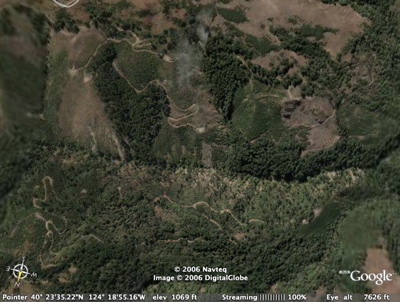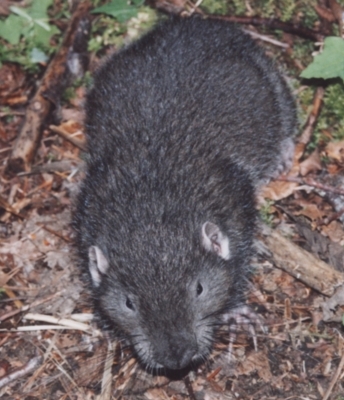From the Open-Publishing Calendar
From the Open-Publishing Newswire
Indybay Feature
"Windmill" Oldgrowth Logging Plan Approval Expected In 14 Days
The logging could start that day or the next. For updates and other info, go to Save Ancient Forests blog

For several years a particularly devastating plan to log hundreds of acres of oldgrowth Douglas Fir forest has been awaiting approval.On April 1st Sierra Pacific Industries (SPI) 538 acre timber harvest plan will likely be approved. Logging could begin that day or the next. It has been estimated that 70% of the acreage is Oldgrowth forest, nearly all of the last remaining patches of Oldgrowth Forest in Davis Creek.This plan has been undergoing review since 2003 by the California Dept. of Forestry and other agencies and the decision keeps getting postponed.
Location
The units are scattered across the Davis Creek and South Fork Bear River drainages. This area has been ravaged by logging. This area was sold to SPI in the 70s' by the BLM. At the time, the Davis Creek drainage was blanketed in a lush, coastal Oldgrowth Douglas Fir forest. It has since been ravaged. Aerial photos of the watershed show where the steep hillsides were stripped bald from the ridge all the way down to the creek, triggering landslides that have gone into the creek. Click here to check out the sattelie photo program Google Earth.
The westernmost logging unit is only 3 miles from the rugged beaches of the Pacific coast next to Davis Creek. 74 acres are proposed for clearcut, 96 acres are proposed for "rehab". Rehab is a logging technique where all of the profitable trees like Douglas Fir are cut and removed and then herbicides are used on the remaining hardwood trees, or the hardwoods are cut and the stump sprouts are sprayed a few years later. Then they plant seedlings, often clones, of a valuble species like Douglas Fir or Redwood and the transformation from a forest into a tree farm has been completed. There are plans for bulldozer trails criscrossing hillsides to drag huge logs around and for cranes called "cable yarders" to drag these logs up steep slopes, digging furrows into the hillside. These practices destroy the topsoil through erosion and compaction.
Mountain Beavers
There is a very rare mammal that lives in this area. It is known as the Mountain Beaver but is actually an older form of rodent (Aplodontia rufa). It is unknown which of the three subspecies of Aplodontia occupies this area. One subspecies, the Point Arena Mountain Beaver is Federally listed as endangered. Fish and Game said that SPI shouldn't be required to identify them because logging their habitat wouldn't negativly affect them. The Mountain Beavers live in underbrush near wet places. They need soft, wet soil for burrowing in and to provide lush vegetation for food. The company has permission to clear-cut the trees in and around the two known locations occupied by Mountain Beavers and then drag the logs up the hill with Cable Yarders. After that they will probably spray herbicides to kill the remaining brush. This kind of logging results in a dead zone of smashed limbs, logs and dead brush, all of which are tinder dry in the summer. Another option they have is to burn what remains. On slopes that are greater than 60% they will "broadcast burn" a.k.a. napalm the hillside. On slopes less than 60% they will do "mechanical pile and burning of the piles", what some have dubbed "tractor derbys". The one protection the Mountain Beavers are given in the plan is that SPI cannot drive tractors over their colonies. If any Mountain Beavers do survive this, the loss of the trees brings a new threat of predators like Red Tail Hawks and Golden Eagles.
Motive for Killing Mountain Beavers
Here is a blurb from Animal Diversity Web about Mountain Beavers. It sheds more light on the threat facing the creatures:
"Foraging by the mountain beavers on seedlings in areas undergoing reforestation can lead to environmental and economic damage. They also cause garden damage and raid the crops of farmers. To prevent further damage by the mountain beavers, people take various types of action. One is to reduce the food consumed by mountain beavers by using herbicides and burning. Another method is to control the population directly by traps or through using toxic baits. Plastic mesh has also been put around trees that the mountain beavers destroy. These prevention measures add to a considerable amount of money (Carraway, 1993)."
Red Tree Voles
The area is also populated with Sonoma Tree Voles, a weakly protected subspecies of the Red Tree Vole. Like their cousins, just about the only thing these mouse like creatures eat is Douglas Fir needles and rarely, if ever, come to the ground.
Location
The units are scattered across the Davis Creek and South Fork Bear River drainages. This area has been ravaged by logging. This area was sold to SPI in the 70s' by the BLM. At the time, the Davis Creek drainage was blanketed in a lush, coastal Oldgrowth Douglas Fir forest. It has since been ravaged. Aerial photos of the watershed show where the steep hillsides were stripped bald from the ridge all the way down to the creek, triggering landslides that have gone into the creek. Click here to check out the sattelie photo program Google Earth.
The westernmost logging unit is only 3 miles from the rugged beaches of the Pacific coast next to Davis Creek. 74 acres are proposed for clearcut, 96 acres are proposed for "rehab". Rehab is a logging technique where all of the profitable trees like Douglas Fir are cut and removed and then herbicides are used on the remaining hardwood trees, or the hardwoods are cut and the stump sprouts are sprayed a few years later. Then they plant seedlings, often clones, of a valuble species like Douglas Fir or Redwood and the transformation from a forest into a tree farm has been completed. There are plans for bulldozer trails criscrossing hillsides to drag huge logs around and for cranes called "cable yarders" to drag these logs up steep slopes, digging furrows into the hillside. These practices destroy the topsoil through erosion and compaction.
Mountain Beavers
There is a very rare mammal that lives in this area. It is known as the Mountain Beaver but is actually an older form of rodent (Aplodontia rufa). It is unknown which of the three subspecies of Aplodontia occupies this area. One subspecies, the Point Arena Mountain Beaver is Federally listed as endangered. Fish and Game said that SPI shouldn't be required to identify them because logging their habitat wouldn't negativly affect them. The Mountain Beavers live in underbrush near wet places. They need soft, wet soil for burrowing in and to provide lush vegetation for food. The company has permission to clear-cut the trees in and around the two known locations occupied by Mountain Beavers and then drag the logs up the hill with Cable Yarders. After that they will probably spray herbicides to kill the remaining brush. This kind of logging results in a dead zone of smashed limbs, logs and dead brush, all of which are tinder dry in the summer. Another option they have is to burn what remains. On slopes that are greater than 60% they will "broadcast burn" a.k.a. napalm the hillside. On slopes less than 60% they will do "mechanical pile and burning of the piles", what some have dubbed "tractor derbys". The one protection the Mountain Beavers are given in the plan is that SPI cannot drive tractors over their colonies. If any Mountain Beavers do survive this, the loss of the trees brings a new threat of predators like Red Tail Hawks and Golden Eagles.
Motive for Killing Mountain Beavers
Here is a blurb from Animal Diversity Web about Mountain Beavers. It sheds more light on the threat facing the creatures:
"Foraging by the mountain beavers on seedlings in areas undergoing reforestation can lead to environmental and economic damage. They also cause garden damage and raid the crops of farmers. To prevent further damage by the mountain beavers, people take various types of action. One is to reduce the food consumed by mountain beavers by using herbicides and burning. Another method is to control the population directly by traps or through using toxic baits. Plastic mesh has also been put around trees that the mountain beavers destroy. These prevention measures add to a considerable amount of money (Carraway, 1993)."
Red Tree Voles
The area is also populated with Sonoma Tree Voles, a weakly protected subspecies of the Red Tree Vole. Like their cousins, just about the only thing these mouse like creatures eat is Douglas Fir needles and rarely, if ever, come to the ground.
For more information:
http://saveancientforests.blogspot.com
Add Your Comments
We are 100% volunteer and depend on your participation to sustain our efforts!
Get Involved
If you'd like to help with maintaining or developing the website, contact us.
Publish
Publish your stories and upcoming events on Indybay.
Topics
More
Search Indybay's Archives
Advanced Search
►
▼
IMC Network



